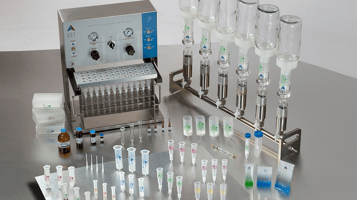When it comes to transferring small volumes of liquid with accuracy and ease, the Pasteur pipette...
The Basics of Peristaltic Pumps & Tubing
Peristaltic pumps (also known as a roller pump) work using a process known as peristalsis, which uses compression and relaxation to move fluids through a tube or pipe. The pump used tubing of a specific size to deliver a known quantity of fluid. The tubing inside the pump is in a circular position and a series of rollers (or shoes) compress the tube as they rotate, creating a vacuum which draws a known quantity of fluid through the tube. The rotor has several "wipers" or "rollers" attached to its external circumference, compressing the flexible tube as it rotates. Under compression, the part of the tube is closed, forcing the fluid to move through the tube. Peristaltic tubing is design to return to its original shape after the rollers have passed over so the quantity and flow of fluid is consistently maintained. A bridge, sometimes called a 'stop' is a plastic attachment to the tube that locks the tube in position on a peristaltic pump. Bridges are colour coded to easily identify the size of the tubing

How do I choose the right size tubing for my peristaltic pump?
Peristaltic pump tubing sizes vary depending on the material, elasticity, and flow rate of the tubing. The size of particles that can pass through the tubing should be less than a certain percentage of the tubing's inner diameter. The wall thickness of the tubing must match up with the gap between the roller and the housing in the peristaltic pump. Even a difference of .005" in wall thickness can significantly reduce the pump's life or stop it from working.
When choosing a tubing size, follow the pump manufacturer's recommendations to ensure good performance.
What brands of Peristaltic Pumps are available?
There are many brands of peristaltic pumps available for chromatography. Some of the popular ones are:
- Watson-Marlow Fluid Technology Group
- Cole-Parmer
- Ismatec
- Masterflex
- Chromatography Direct
What are the advantages of Peristaltic Pumps?
Peristaltic pumps have several advantages:
- They are self-priming and can run dry without damage.
- They offer a very sensitive pumping action.
- They can handle abrasive solids.
- They are often used in laboratory applications to pump viscous liquids or gases.
- The fluid is contained in a flexible tube fitted inside a circular pump casing. Nothing but the pump tube or hose touches the liquid, eliminating the risk of the pump contaminating the fluid or the fluid contaminating the pump.
See the Chromatography Direct Range of Tubing for Peristaltic Pumps and ICP Tubing >> https://info.chromatographydirect.com/peristaltic-pump-and-icp-tubing




